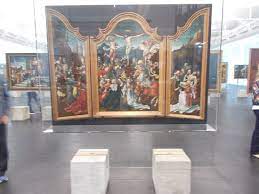Gemäldegalerie Alte Meister
Gemäldegalerie Alte Meister
The Gemäldegalerie Alte Meister (German pronunciation: , Old Masters Gallery) in Dresden, Germany, houses approximately 750 paintings dating from the 15th to the 18th centuries. It includes major works from the Italian Renaissance as well as Dutch and Flemish paintings. Outstanding works by German, French, and Spanish painters of the time are also on display at the gallery.
The Dresden State Art Collections house the Old Masters. The collection is housed in the Semper Gallery, the Zwinger's gallery wing.
History
Around 1830, an interior view of the Royal Painting Collection.
When Augustus, Elector of Saxony, founded the Kunstkammer (Art Chamber) of the Electors of Saxony in Dresden in 1560, paintings were subordinate to collectors' pieces from science, other art works, and curiosities.
Augustus II the Strong and his son Frederick Augustus II did not begin collecting paintings systematically until the early 18th century. These two art-loving Electors of Saxony, who were also Kings of Poland, significantly expanded the collections in less than 60 years. The 100 best pieces from the Duke of Modena's (Francesco III's) collection were purchased in 1745 and arrived in Dresden the following year. As the rapidly expanding painting collection grows,As the rapidly expanding painting collection required more storage and display space, it was relocated from Dresden Castle to the adjacent Stallgebäude (Electors' Stables Building) in 1747. Meanwhile, the collection had become well-known in Europe. Paintings from all over Europe, particularly Italy, Paris, Amsterdam, and Prague, were purchased and shipped to Dresden. The Electors' purchasing spree culminated in the purchase of Raphael's Sistine Madonna in 1754. The Dresden painting gallery became not only one of Northern Europe's most famous Old Masters collections, but also a forerunner of the modern museums that would emerge in the late 18th century. In 1838, a gallery commission working for King Frederick Augustus II commissioned the architect Gottfried Semper to design an appropriate architectural setting for the collection. As a result, the new gallery wing of the Zwinger was constructed between 1847 and 1854. The Neues Jahrbuch was published on September 25, 1855.The Neues Königliches Museum (New Royal Museum) debuted in the Semper Gallery, where it remains today.




Comments
Post a Comment